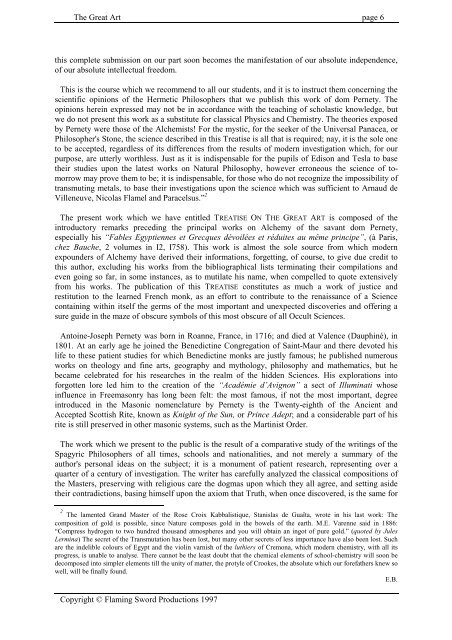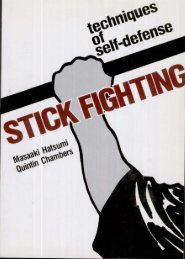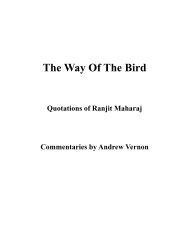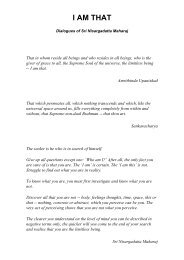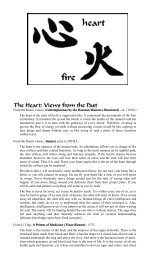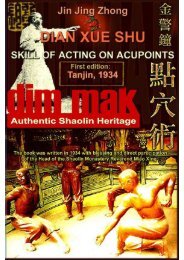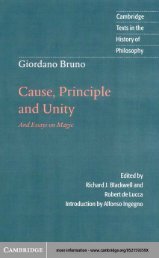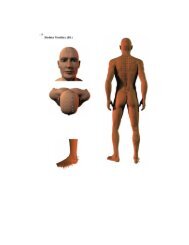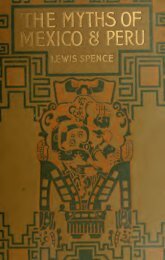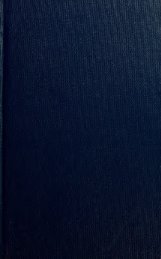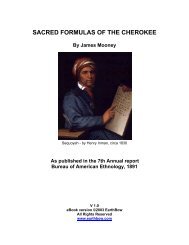The Great Art
Create successful ePaper yourself
Turn your PDF publications into a flip-book with our unique Google optimized e-Paper software.
<strong>The</strong> <strong>Great</strong> <strong>Art</strong> page 6<br />
this complete submission on our part soon becomes the manifestation of our absolute independence,<br />
of our absolute intellectual freedom.<br />
This is the course which we recommend to all our students, and it is to instruct them concerning the<br />
scientific opinions of the Hermetic Philosophers that we publish this work of dom Pernety. <strong>The</strong><br />
opinions herein expressed may not be in accordance with the teaching of scholastic knowledge, but<br />
we do not present this work as a substitute for classical Physics and Chemistry. <strong>The</strong> theories exposed<br />
by Pernety were those of the Alchemists! For the mystic, for the seeker of the Universal Panacea, or<br />
Philosopher's Stone, the science described in this Treatise is all that is required; nay, it is the sole one<br />
to be accepted, regardless of its differences from the results of modern investigation which, for our<br />
purpose, are utterly worthless. Just as it is indispensable for the pupils of Edison and Tesla to base<br />
their studies upon the latest works on Natural Philosophy, however erroneous the science of tomorrow<br />
may prove them to be; it is indispensable, for those who do not recognize the impossibility of<br />
transmuting metals, to base their investigations upon the science which was sufficient to Arnaud de<br />
Villeneuve, Nicolas Flamel and Paracelsus.” 2<br />
<strong>The</strong> present work which we have entitled TREATISE ON THE GREAT ART is composed of the<br />
introductory remarks preceding the principal works on Alchemy of the savant dom Pernety,<br />
especially his “Fables Egyptiennes et Grecques dévoilées et réduites au même principe”, (à Paris,<br />
chez Bauche, 2 volumes in I2, I758). This work is almost the sole source from which modern<br />
expounders of Alchemy have derived their informations, forgetting, of course, to give due credit to<br />
this author, excluding his works from the bibliographical lists terminating their compilations and<br />
even going so far, in some instances, as to mutilate his name, when compelled to quote extensively<br />
from his works. <strong>The</strong> publication of this TREATISE constitutes as much a work of justice and<br />
restitution to the learned French monk, as an effort to contribute to the renaissance of a Science<br />
containing within itself the germs of the most important and unexpected discoveries and offering a<br />
sure guide in the maze of obscure symbols of this most obscure of all Occult Sciences.<br />
Antoine-Joseph Pernety was born in Roanne, France, in 1716; and died at Valence (Dauphiné), in<br />
1801. At an early age he joined the Benedictine Congregation of Saint-Maur and there devoted his<br />
life to these patient studies for which Benedictine monks are justly famous; he published numerous<br />
works on theology and fine arts, geography and mythology, philosophy and mathematics, but he<br />
became celebrated for his researches in the realm of the hidden Sciences. His explorations into<br />
forgotten lore led him to the creation of the “Académie d’Avignon” a sect of Illuminati whose<br />
influence in Freemasonry has long been felt: the most famous, if not the most important, degree<br />
introduced in the Masonic nomenclature by Pernety is the Twenty-eighth of the Ancient and<br />
Accepted Scottish Rite, known as Knight of the Sun, or Prince Adept; and a considerable part of his<br />
rite is still preserved in other masonic systems, such as the Martinist Order.<br />
<strong>The</strong> work which we present to the public is the result of a comparative study of the writings of the<br />
Spagyric Philosophers of all times, schools and nationalities, and not merely a summary of the<br />
author's personal ideas on the subject; it is a monument of patient research, representing over a<br />
quarter of a century of investigation. <strong>The</strong> writer has carefully analyzed the classical compositions of<br />
the Masters, preserving with religious care the dogmas upon which they all agree, and setting aside<br />
their contradictions, basing himself upon the axiom that Truth, when once discovered, is the same for<br />
2 <strong>The</strong> lamented Grand Master of the Rose Croix Kabbalistique, Stanislas de Guaïta, wrote in his last work: <strong>The</strong><br />
composition of gold is possible, since Nature composes gold in the bowels of the earth. M.E. Varenne said in 1886:<br />
“Compress hydrogen to two hundred thousand atmospheres and you will obtain an ingot of pure gold.” (quoted by Jules<br />
Lermina) <strong>The</strong> secret of the Transmutation has been lost, but many other secrets of less importance have also been lost. Such<br />
are the indelible colours of Egypt and the violin varnish of the luthiers of Cremona, which modern chemistry, with all its<br />
progress, is unable to analyse. <strong>The</strong>re cannot be the least doubt that the chemical elements of school-chemistry will soon be<br />
decomposed into simpler elements till the unity of matter, the protyle of Crookes, the absolute which our forefathers knew so<br />
well, will be finally found.<br />
E.B.<br />
Copyright © Flaming Sword Productions 1997


